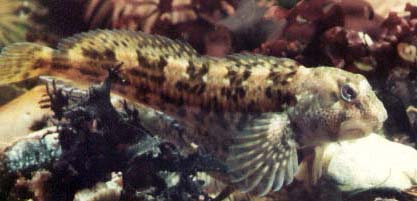
Identification:
A small to medium-sized
blenny, elongate small fish of a large family of fishes that live in rocky
areas in shallow water. All true blennies have a continuous dorsal fin;
the first dorsal fins spiny and the remainder soft. The pectoral fins are
relatively large. The pelvic fin is in a jugular position.

Distinguished by the absence
of tentacles/lappets over the eye. Usually green with black mottling, adults
may be grey with black. Males in breeding livery go all black with a white
mouth and an attractive pale blue fringe to the long dorsal fin.
If the small green blenny
has blue spots and a lappet over the eye it is the similar but rarer Coryphoblennius
galerita.
Similar species: Coryphoblennius
galerita;
Parablennius gattorugine (Tompot
Blenny). and the Peacock Blenny,
Salaria
pavo.
The presence or absence
of the eye tentacles are definitive. See link.
Paralipophrys
trigloides (southern species: Fishbase entry)
Blenny
from Malta (identified as Paralipophrys trigloides)
Paralipophrys
trigloides (link)
Breeding:
Spring, in very shallow
water, sometimes intertidal.
In
Sussex, intertidal breeding occurs, but I expect it also occurs offshore,
because of the abundance of the young on the shore in summer.
Breeding
Congregation (Link to a Photograph)
Breeding
Report:
The
male in breeding livery goes dark , almost black, with white lips.
I have
a tank in which I have a blenny that has laid eggs. A blenny laid eggs
on the side of the tank A month or two ago but despite my attempts I was
unable to stop the wrasse in my tank eating them, in fact it was their
jaw noise that alerted me to the eggs.
I
now have on both sides of rock (an overhang) a patch of eggs that is about
2 inches square completely covered in eggs. It is nearly impossible for
the wrasse to get these. I also have two blennies which appear to be laying
over the eggs like a bird does over its eggs. Sometimes there is the one,
a blenny which appears to have gone very black and a lighter one replaces
it every so often . What can I expect , anything? , What can I do to help?
Do blennies lay eggs and then one of them has to fertilise the eggs once
laid?
Andy Byres
With
a bit of luck you should have hundreds, possibly thousands of Blenny fry
in a week or two. I made a 25% water change prior to the eggs hatching
and I was surprised at the numbers of fry because it did not realise they
had laid eggs. The water change may have helped the eggs to hatch, or they
may have hatched anyway. I don't know. The Blennies bred the following
year. I have never been able to get any other Blennies to breed. Getting
a pair maybe the reason and Blennies that have been grown to full size
in aquaria do not seem to be so keen. The darker male Blenny guards the
eggs and the lighter one is the female.
My
observations of the Common Blenny of the NE Atlantic, indicate that hatching
can be provoked by making a large water change corresponding to physical
pressure on the eggs, perhaps corresponding to wave action as this small
fish breeds intertidally and in shallow water.
Habitat:
Rocky areas below low water
mark, intertidal (mid-shore and below) from spring to autumn*, under
rocks, in crevices and rock pools, especially the juveniles. This fish
habitually leaves oxygen-deficient pools and can be seen basking on rocks
and completely out of the water at low tide.
(* in the south-west this fish
can be found on the shore during the winter).
Gregarious, but there have
been reports of serious fighting in aquaria.
Food:
Small invertebrates including acorn barnacles, molluscs especially the
Grey Topshell,
Gibbula
cineraria.
Range:
All British coasts. Not much further afield though. This is a true representative
of the British fauna. The prevalence of this fish on north-eastern coasts
and north Scotland is not known and any information , including absences,
would be of interest.
It
is absent (or very rare) at the Swedish coast, but is present in Norway,
a distribution common to many intertidal organisms - there's virtually
no tide at the Swedish coast. It is reportedly found in western Norway
from Egersund to Sogn. I am fairly sure I saw several
at
Bergen.
Michael
Norén, Doctoral student.
Southern
distribution under enquiry (see Wet
Thumb messages.)
Replaced
by Paralipophrys
trigloides in the Mediterranean.
Behaviour:

The
Common
Blenny is found out of the water at low tide
for two reasons:
1)
Left stranded by the receding tide
2)
Jump (hop) habitually out of rock pools deficient in oxygen (or too warm)
in hot weather. This happens more often at night.
Enemies:
Larger
fish including Bullheads and Bass.
Sea
Birds.
Additional
Notes:
A common fish familiar to
rockpoolers.
I caught a Blenny
at Kingston Beach, Shoreham, in early 2013
at a length of 185 mm excluding the tail fin..It
was grey in colour. It weighed exactly 2 oz.
That is only 56.7 grams
though. .
Record
Angling Catch: SHANNY
(Lipophrys pholis)
3-15 111g Poldhu Cove, SW. Cornwall
M Carter 1995
This fish should NOT be collected
for live bait because of it lays a small number of eggs would be vulnerable
to exploitation, because the large fish on the shore are breeding, with
the males guarding the eggs and the females ovigerous. (Males will attack
any intruders and bite fingers). Furthermore, collection would spoil to
enjoyment of a rocky shore for rockpoolers and other visitors. As a bait
it is inferior to live prawn.
Reports:
My
daughter (aged 5) caught 6 of these off Lyme Regis
Cobb with her crab line using squid bait on July 27 at 16:00 approx.
There
were plenty of them and were easily identified - completely spine free
and soft.
I found
a fish in a rockpool at Lundy Bay near Polzeath in North Cornwall last
week (August 2001).
I did not know what it was until I identified it on your website.
It
was 8 cm long (approx.) and went under the seaweed.
.

Issac
Livesey with a Blenny caught at Brixham, Devon, in July 2002
15
August 2002
The Blenny has grown to
13 cm (excluding its tail fin) in my aquarium.
AH
3
October 2003
I
wish I kept more accurate notes of capture notes, but it appear that the
Blenny, Lipophrys pholis, lives for four or five years in captivity
and dies of old age at a length of 155 mm, excluding the tail fin. With
the caudal fin the length is 177 mm (7 inches). However, this appears to
be the male fish. the females are still living. It could have died for
another reason. AH.
4
February 2004
A
Blenny has died in my aquarium at the maximum local length of 15.5 cm (excluding
the 22 mm caudal fin). They appear to live 5 or 6 years in captivity. It
is the same one or same group as the above. AH
20
February 2005
My son and I were rockpooling
in Bangor on the shores of Belfast Lough, and in the space of two hours
we found in the region of forty Common Blennies
. Most of the Blennies were found under large rocks about 10 metres
from the low water mark. They ranged in size from approx. 2 cm. to 10 cm.
and presumably because they were mating we found up to 11 under one rock.
Miscellaneous:
In medieval times, this
fish, known as a Sea Frog, was used as one of the ingredients, with eggs,
in hair shampoo, in Italy (related species) and France. (Source: researcher
into medieval recipes.)
blenny
| bleni | n. M18. [f. L blennius f. Gk blennos slime
(with ref. to the mucous coating of the scales).] Any of various small
spiny-finned marine fishes belonging to the Blenniidae or a related family,
most of which are bottom-dwelling fishes of intertidal and shallow inshore
waters.
BUTTERFLY
blenny. smooth blenny: see SMOOTH a. & adv. viviparous blenny: see
VIVIPAROUS 1.
---------------------------------------------------------
Excerpted
from The Oxford Interactive Encyclopedia
Developed
by The Learning Company, Inc. Copyright (c) 1997 TLC Properties Inc.
Information wanted: Please
send any records of this fish, with location, date, who discovered it,
how it was identified, prevalence, common name and any other details to
Shorewatch
Project EMail Glaucus@hotmail.com.
Shorewatch Reports
Blennies were especially
numerous in May 2000 at Kingston Beach,
Shoreham.

All messages will receive
a reply.
Link:
All Species of Blennies from around Britain
Differences
between Blennies & Gobies
|






